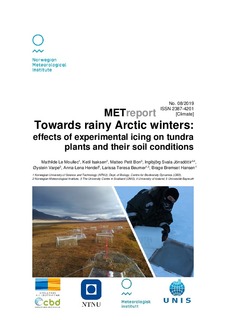| dc.contributor.author | Le Moullec, Mathilde | |
| dc.contributor.author | Isaksen, Ketil | |
| dc.contributor.author | Petit Bon, Matteo | |
| dc.contributor.author | Jónsdóttir, Ingibjörg Svala | |
| dc.contributor.author | Varpe, Øystein | |
| dc.contributor.author | Hendel, Anna-Lena | |
| dc.contributor.author | Beumer, Larissa Teresa | |
| dc.contributor.author | Hansen, Brage Bremset | |
| dc.date.accessioned | 2020-01-14T11:41:55Z | |
| dc.date.available | 2020-01-14T11:41:55Z | |
| dc.date.created | 2020-01-07T22:37:02Z | |
| dc.date.issued | 2019 | |
| dc.identifier.uri | http://hdl.handle.net/11250/2636170 | |
| dc.description.abstract | Global warming comes with more frequent extreme climate events. In the Arctic, extreme warm spells with heavy rain-on-snow events in winter can cause dramatic changes to the snow-pack and encapsulate the vegetation in thick basal ice for several months. Ice-locked tundra can cause population crashes in Arctic herbivores by limiting food plant availability, yet specific effects on the vegetation and soil layer properties are still largely unknown. We performed a four-year field experiment in mesic communities in high Arctic Svalbard to assess effects of ice-encasement on seasonal plant growth and reproductive traits, as well as soil temperature at different depths. Simulated rain-on-snow and resultant icing were further combined with summer warming (by Open Top Chambers) in a full-factorial generalized randomized block design. Icing caused a delay in community-level productivity (measured as Normalized Difference Vegetation Index, NDVI) but also increased peak productivity in some years, compared with untreated (and warmed) plots. However, this occurred at the cost of reduced flower production in the icing plots. The delay in productivity was associated with a delay of both the thawing and spring-summer temperature increase in the upper soil active layer (especially 10-20 cm depth), which can affect plant roots. However, natural inter-annual variability in spring-summer weather, which caused shifts in spring onset (defined as when soil temperatures reach 0°C) of more than 3.5 weeks, exceeded most effects caused by icing or warming treatments. Our findings indicate that icing events mainly impact the soil-vegetation system by causing delays in seasonal development, followed by compensatory plant responses. However, they also suggest an overall resistance to such extreme events in this highly fluctuating environment. Thus, these results from high Arctic mesic vegetation – with absence of evergreen shrubs – contrast with some recent observations of “Arctic browning”, which have been linked with changes in winter weather events and snow conditions. | nb_NO |
| dc.language.iso | eng | nb_NO |
| dc.publisher | Norwegian Meteorological Institute | nb_NO |
| dc.relation.ispartof | MET report | |
| dc.relation.ispartofseries | MET report; | |
| dc.relation.uri | http://met-xpprod.customer.enonic.io/publikasjoner/met-report | |
| dc.title | Towards rainy Arctic winters: effects of experimental icing on tundra plants and their soil conditions | nb_NO |
| dc.type | Research report | nb_NO |
| dc.description.version | publishedVersion | nb_NO |
| dc.source.pagenumber | 31 | nb_NO |
| dc.source.issue | 08/2019 | nb_NO |
| dc.identifier.cristin | 1768111 | |
| dc.relation.project | Svalbards miljøvernfond: 16/113 | nb_NO |
| dc.relation.project | Norges forskningsråd: 276080 | nb_NO |
| dc.relation.project | Norges forskningsråd: 223257 | nb_NO |
| cristin.unitcode | 194,66,10,0 | |
| cristin.unitname | Institutt for biologi | |
| cristin.ispublished | true | |
| cristin.fulltext | original | |
